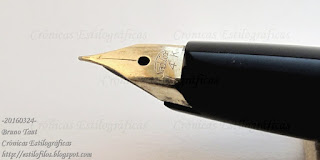Around 1970, Sailor made some wooden pens in small and limited editions. The first of them was an ebony pen made in 1968 to commemorate the 100th anniversary of the beginning of the Meiji period. Then, some other models followed in ebony and ironwood, and some of them were decorated with maki-e designs. Acording to Masa Sunami (A LAMBROU & M SUNAMI. Fountain Pens of Japan. 2012), over 30 different patterns were produced in several of the traditional techniques of maki-e in Japan: Wajima-nuri, Tsugaru-nuri, and Kimma-nuri.
Such is the case of the pen on display today—a Sailor made of ebony wood with a maki-e motif in the Wajima-nuri style. Wajima is a city in Noto Peninsula (Ishikawa Prefecture) with a long tradition in urushi-related techniques. This dates back to, at least, the 15th century, and nowadays Wajima is the origin of the largest production of urushiware in Japan. In fact, Wajima-nuri says more about the origin of the piece than about the actual technique employed on it.
The pen shows a theme of hôô (鳳凰, phoenix) in taka-maki-e technique (raised, with some relief over the surface). The ebony grain is visible under the transparent urushi. The pen is not signed.
Pen-wise, this is a cartridge-converter unit with a 23 K gold nib, dated November of 1972. That was at the peak of the gold fever among pen makers in Japan.

The nib is made of 23 K gold. Its nib point is M, or 4 in the Sailor system of nib points of the time. Note the three ink channels of the feed.
These are the dimensions of the pen:
Length closed: 140 mm
Length open: 121 mm
Length posted: 160 mm
Diameter: 13.8 mm
Weight: 30.2 g (dry)
Ink deposit: 1.2 ml (cartridge) / 0.7 ml (converter)
Platinum Platinum pocket pen – Aurora Black
Bruno Taut
Nakano, April 6th, 2016
etiquetas: Sailor, maki-e
Bruno Taut
Nakano, April 6th, 2016
etiquetas: Sailor, maki-e












































